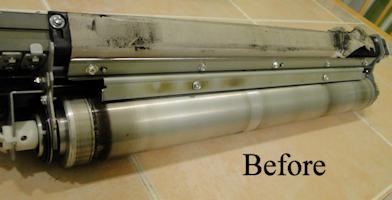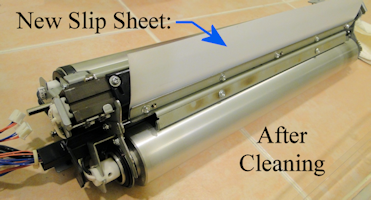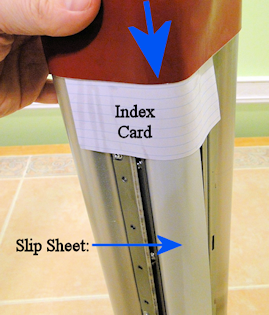Xerox
Xerox® Versant® 80, 2100 Press, Genuine Fuser Drive Gear Bracket Assembly 007k98681
- SKU:
- 007K98681
- UPC:
- 007K98681
- Condition:
- New
- Availability:
- Usually Ship same Day
- Weight:
- 1.5 KGS
Description
IMPORTANT: The information presented here is for the use of a qualified, experienced technician. Without the background knowledge which comes with training, you risk doing more damage then good to the copier & also risk your own safety. If you are not willing to take 100% responsibility for your actions, do not use the information posted here. Thank you. Read our conditions of Use for more information.
V80 style Heat Belt Unit - Repairing and Rebuilding
Repair or Rebuild your Versant® V80/V2100 Fuser Heat Belt Unit
| Technical Specifications |
|---|
|
V80 Heat Belt Unit Rebuild Instructions for Xerox® models: (Versant®) V80, V180, V2100, V3100
The newest “Cadillac” of full color Xerox® copiers are increasing in popularity in leaps and bounds. The Versant® series are phenomenal machines in general. Of course as with any newly introduced equipment, there are challenges to overcome. One early complaint relates to the shorter than stated yield, and rather high cost, of the Fuser Heat Belt Units. Let’s look at ways to increase the longevity and we’ll also go over the steps to refurbish one of these units.
The Fuser Heat Belt Unit is only shown in the OEM parts book as a complete unit. It is sold under the part numbers 126K34853 or 001R00620. At last check it retailed for just over £1400.-. You can now get the Heat Belt Kit from us (V80FHBK) if your Heat Belt is beyond saving. The kit also includes the Slip Sheet and a small bottle of Heat Belt Oil.
The OEM literature says to expect a yield of 650K, but word is that they don’t make it that far in most cases. The most common failure is a fault code 099-395 (Fusing Unit P/R Motor Current Warning or Pressure Roller Motor Over Current), which is closely related to the fault 010-613. Either code means the machine saw extra strain on the Fuser Drives, or slowing of the belt’s speed. Usually the underlying cause is failure of the Heat Pad or Slip Sheet. This fabric-like piece is found inside the Heat Belt, right where the Pressure Roller makes contact. When the Slip Sheet tears, it bunches up inside the belt and causes extra friction and strain on the drives. The fault can be reset by turning the machine off and back on, but eventually the Heat Belt itself will get damaged if the problem is not addressed.
In particular we are told that any heat belt unit dated before October 2014, or any machine built before that time period, are known to have problems due to lack of lubrication of the Slip Sheet and Oil Wicks inside the Heat Belt.
If the customer knows to call for service right away, rather than continuing to run the machine, you will likely rescue the Heat Belt before it gets too badly damaged.
The fix is to open the unit up, replace the Slip Sheet (V80FHBSS) and make sure to apply plenty of Heat Belt Oil (V80FHBO) to the new slip sheet. At the same time you should sit the two wicks in a Heat Belt Oil bath for a few minutes until they are fully re-lubricated. Then they can do their job as oil reservoirs for the components inside the unit once again. If the belt is damaged badly enough to cause copy quality problems, you may need to replace that as well (V80FHBK).
Now let’s have a look at how to take the Heat Belt off. This way you can get inside to clean the rollers and re-oil or replace the Slip Sheet and the two Heat Belt Oil Wicks. See Photo #1 for orientation of some of the parts mentioned in the first few steps of the procedure.
Photo #1: Orientation
TOOLS & SUPPLIES NEEDED: - #2 Philips Screwdriver (or 5.5mm nut driver) - Pair of 3mm screws (to use as spacers… you’ll see their purpose in the procedure) - Slip Sheet - 25ml. Bottle of Heat Belt Oil - Lintless Cleaning / Oil Applicator Cloth - Index Card - Possibly a new Heat Belt IF the belt is already ruined
PROCEDURE:
1. Remove the Stripper Plate by first taking off the two springs (one at each end, see Photo #2). Then rotate the plate away until it can come off of its mounting pins.
Photo #2: Stripper Plate Springs
Photos #3 & 4: Releiving Tension on the Belt (insert a screw to keep pressure off the belt as shown)
3. Slide the Heat Belt off of the non-drive end of the Unit (be careful as the edge of the Heat Belt will want to hang-up on a metal frame piece (see Photo #5).
Photo #5: Easing the Belt off over the frame piece
4. Remove the two Wicks. Each is held on by 2 screws. You do not need to remove the screws, only loosen them so the metal part of the wicks can slide out from under the mounting screws. 5. Stand the two wicks in a Heat Belt Oil bath. Best to use a long narrow tray (I used a plastic tray which was originally the packing for a drum blade). Give the wicks enough time to suck up as much oil as they can. If you look at the end of the wicks you can see how far the oil has “wicked” up into its reservoir material (see Photo #7). When you remove the wicks from the oil, wipe off any excess oil from the metal and from the edge of the wick material.
Photos #6 & 7: A good Example of a Bad Slip Sheet... and Oil added to wick
6. Next you can remove the old Slip Sheet. It’s held by a flat metal plate with 5 screws. Note that one corner is cut off the Slip Sheet to indicate which end is which. Refer back to Photo #6 for an example of how a failed Slip Sheet looks. 7. Install a new Slip Sheet and oil it using the Cleaning / Applicator Cloth to work the Heat Belt Oil into the weave of the Slip Sheet thoroughly. (see Photo #8)
Photo #8: Install the Slip Sheet and apply oil using a lint free cloth
8. Clean the metal Drive and Tension / Steering Rollers’ surfaces with some of the Heat Belt Oil… this stuff is a magnificent cleaning material for this purpose (see Photos #9 & 10 for Before and After pics). Wipe off any excess oil afterward.
Photos # 9 & 10: Heat Belt Drive Roll Before and After Cleaning. The oil works GREAT for cleaning the unit up.
9. Use the edge of the Index Card to clean off the faces of the 6 Thermistor heads where they touch the two metal rollers and the square piece which the slip sheet covers. Be gentle so as not to damage the yellow Kapton tape on the thermistor heads. Put a little pressure behind the head as you slide the card back and forth a few times to remove any built up residue. 10. Slide the Heat Belt back on using the Index Card as a guide to help ease the Heat Belt over the end of the Slip Sheet. (see Photo #11) This way the Slip Sheet doesn’t get “dog-eared”. Once past the end of the Slip Sheet, remove and discard the Index Card and slide the Heat Belt the rest of the way on.
Photo #11: Using the Index Card to slip the Belt over the end of the Slip Sheet
11. Center the Heat Belt on the metal rollers and then remove the two screws you used as spacers earlier, allowing the Tension Roll to press on the inside of the belt again. 12. Reinstall the Stripper Plate and the spring at either end. The springs’ little “handles” should point in toward the unit.
Voila ! You rescued a Heat Belt Unit! That’s a nice friendly procedure… not too many screws, and not too time consuming. If you also need to replace the Heat Belt Gear, that will be a whole other story. We'll be working up a write-up for that as well. Watch for it and ask us if you need something.
Happy rebuilding everyone!
|
| Information Reference |
|
Written by our own Britt Horvat and first published in the wonderful ENX Magazine |




















